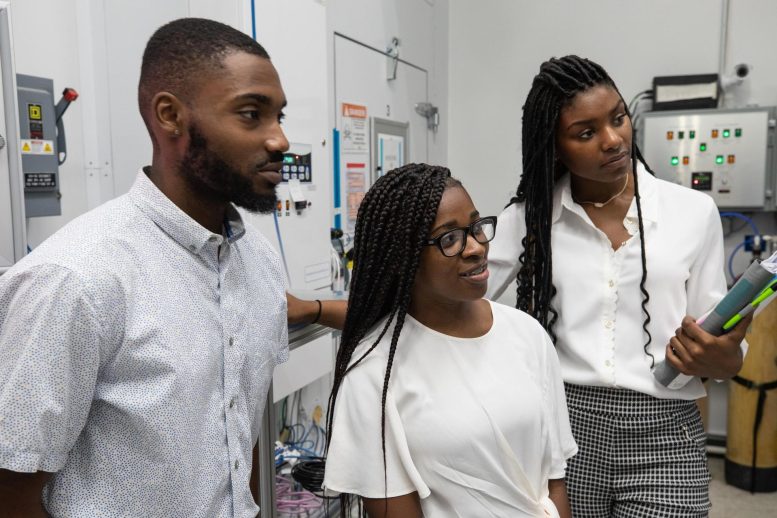
NASA is awarding $11.7 million to eight Historically Black Colleges and Universities (HBCUs) through the new Data Science Equity, Access, and Priority in Research and Education (DEAP) opportunity. These awards will enable HBCU students and faculty to conduct innovative data science research that contributes to NASA’s missions.
“We’re pleased to make progress through awards like this to intentionally build the STEM pipeline of the future, especially in communities of color,” said NASA Deputy Administrator Pam Melroy. “It’s fitting during Black History Month that we make this tangible step to build on the talent pool at HBCUs in our ongoing work to bring to the table all the talents and perspectives we’ll need to send humans to the Moon, Mars and beyond, and do amazing science throughout the solar system.”
Technology advancements in the field of data science, including the growth of artificial intelligence and machine learning, are poised to significantly impact the work of data scientists and analysts. The awarded projects have up to three years to establish institutes and partnerships to increase the number and research capacity of STEM students at HBCUs, accelerate innovation in a wide range of NASA science, technology, engineering, and mathematic research areas, and prepare the future workforce for data-intensive space-based Earth sciences.
“The increasing use of data science at NASA and beyond really drives home the need for a future workforce with data science knowledge,” said Mike Kincaid, associate administrator of NASA’s Office of STEM Engagement, which manages MUREP. “With our newest collaboration, NASA created an exciting pathway to find new talent at HBCUs.”
The agency’s Minority University Research and Education Project (MUREP) and the Science Mission Directorate collaborated on the DEAP opportunity, and selected the following institutions and their proposed projects:
Bethune-Cookman University Inc., Daytona Beach, Florida
NASA MUREP DEAP Institute of Environmental Intelligence for Advanced Space-based Earth Sciences
The project will establish a DEAP Institute focusing on machine learning-based development of a virtual constellation of satellites that will capture changing water levels, from events such as storm flooding to multi-decadal time scales, such as sea level rise. NASA tracks sea level changes and their causes from space.
Fayetteville State University, Fayetteville, North Carolina
Institute for Multi-agent Perception through Advanced Cyberphysical Technologies (IMPACT)
The IMPACT project will build on existing capacity and collaboration with NASA’s Jet Propulsion Laboratory in Silicon Valley, California, to engage students and faculty in using data science to address scientific questions as one of the key factors to manage NASA’s Earth mission research.
Florida A & M University, Tallahassee, Florida
Effects of Gravity on Creeping Salts and Salt Mixtures: Developing Image-based and AI-enhanced Diagnostics for Determining Chemical Compositions
This project will rely on artificial intelligence and machine learning to better understand the science of concentrated salt solutions and the formation of ring-like deposits called evaporites. Understanding the science of salt concentrations and formation of evaporites will bring new insight into identifying where water may have existed. Water is a critical source NASA researches and explores to better understand other planets’ surface geology and the potential future of lunar and Martian exploration.
Lincoln University, Jefferson City, Missouri
Using Data Science to Understand Soil, Wildfire, & Social Disparity of Climate Change and Air Pollution
This project aims to provide data science problem-solving, skill development, and professional development of minority and underserved students. Students will utilize existing state-of-the-art ML methods to develop new data analytic approaches to solve some of the core problems in Earth science research.
Morgan State University, Baltimore
Long-Term, High-Resolution Urban Aerosol Database for Research, Education and Outreach
Through innovative data analysis algorithms, including ML/AI methods, this project will produce a high-resolution, open-access, and user-friendly urban aerosol database focusing on the Baltimore-Washington area. The database will also be used in both classroom teaching and scientific outreach, accompanied by online tools and educational materials bringing new, authentic Earth science education to local schools and communities.
North Carolina Agricultural & Technical State University, Greensboro, North Carolina
DEAP Institute: Harnessing Data Science for Flood Monitoring and Management
Three North Carolina-based HBCUs will work together on this project developed to harness data science for flood monitoring and management.
North Carolina Central University, Durham, North Carolina
Capacity Building to Support the Machine Learning-Based Detection of Floods and other Natural Hazard Impacts in the Department of Environmental, Earth and Geospatial Sciences at North Carolina Central University
This project will create training, data resources, and opportunities to use machine learning/artificial intelligence to identify and measure the impact of flood events and other natural hazards such as earthquakes, hurricanes, drought, wildfires, and more.
Prairie View A & M University, Prairie View, Texas
DEAP Institute in Research and Education for Science Translation via Low-Resource Neural Machine Translation
This project aims to build an AI-based system that can share interactive, instantaneous, and user-relevant Earth science information, making NASA science more discoverable and accessible to a broad audience.
“NASA is tackling how to use the latest techniques in data science combined with the volumes of data produced by our missions to answer questions about our changing planet,” said Steven Crawford, senior program executive for scientific data and computing. “Working with students from HBCUs will not only engage the generation that will be most affected by these subjects but will help NASA scientists and engineers address these challenges.”
Administered by OSTEM, MUREP supports and invests in the research, academic, and technology capabilities of Minority Serving Institutions. For more information about NASA’s Office of STEM Engagement, visit stem.nasa.gov.
Never miss a breakthrough: Join the SciTechDaily newsletter.
2 Comments
is this reparations?
Clear and present racism. Seems certain groups can’t cut it on their own.